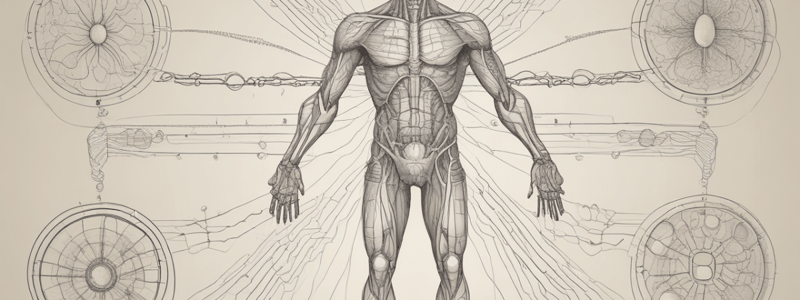Podcast
Questions and Answers
What is the primary goal of homeostasis in the body?
What is the primary goal of homeostasis in the body?
What are the three main components of automatic control systems involved in homeostasis?
What are the three main components of automatic control systems involved in homeostasis?
How does the nervous system communicate with different parts of the body?
How does the nervous system communicate with different parts of the body?
What type of response does the endocrine system provide?
What type of response does the endocrine system provide?
What mechanism allows automatic control systems to work in homeostasis?
What mechanism allows automatic control systems to work in homeostasis?
What is the purpose of receptors in automatic control systems?
What is the purpose of receptors in automatic control systems?
Flashcards are hidden until you start studying
Study Notes
- Homeostasis is the process of maintaining a stable internal environment within the body, ensuring that cells function properly under optimal conditions.
- Cells require specific conditions to function, including a stable temperature, pH level, and adequate supply of glucose and water.
- The body regulates internal conditions to maintain a stable environment, despite changes in external conditions, such as walking in the snow or running in the desert.
- Homeostasis involves automatic control systems that recognize changes from optimal conditions, send signals to reverse the change, and return levels to normal.
- Automatic control systems consist of three main components: receptors that detect changes, coordination centers that interpret and decide on responses, and effectors that carry out the responses.
- Receptors, coordination centers, and effectors may be located in different parts of the body, requiring communication through the nervous and endocrine systems.
- The nervous system sends fast and precise electrical impulses through nerves, allowing for quick responses to stimuli, such as touching a sharp object.
- The endocrine system relies on hormones, which are released into the bloodstream and affect specific cells with the right receptors, providing a slower and more generalized response.
- Negative feedback is the mechanism by which automatic control systems work, decreasing or increasing levels of a substance to return it to normal when it gets too high or too low.
- Negative feedback involves a loop of detection, response, and reversal of changes, maintaining a stable internal environment.
Studying That Suits You
Use AI to generate personalized quizzes and flashcards to suit your learning preferences.




